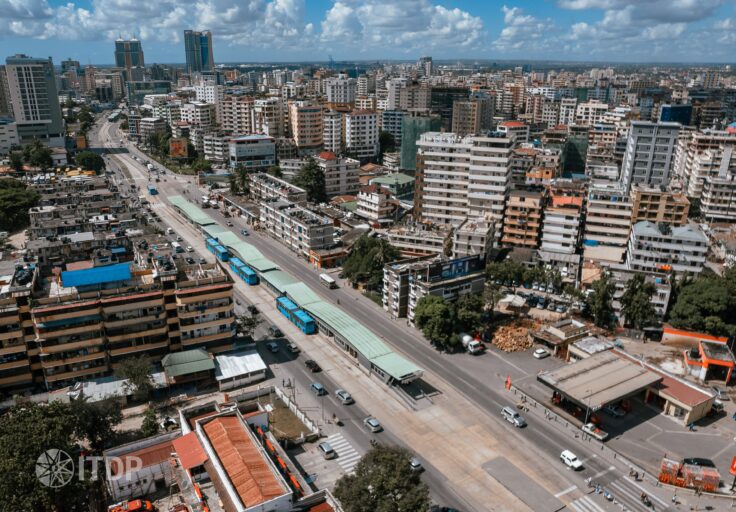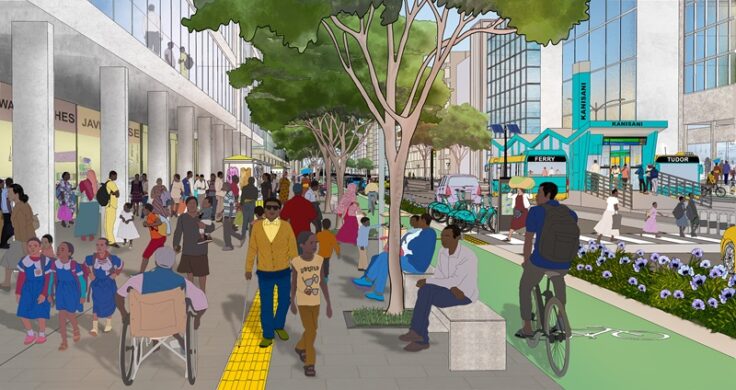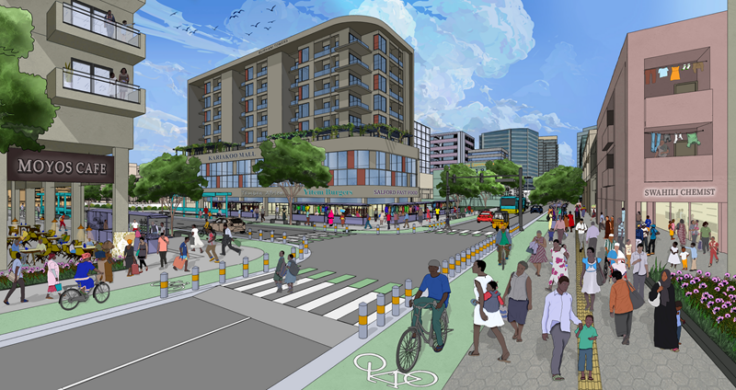February 13, 2024
Fostering Sustainable, Accessible African Cities Through TOD
A version of this article was originally published in the No. 35 issue of the Sustainable Transport Magazine. Read it here.
By Carolyne Mimano and Christopher Kost, ITDP Africa
Rapid urbanization is creating complex, multifaceted challenges and opportunities around the world. African cities are undeniably at the forefront of this phenomenon. As Africa’s cities grow, they must implement more sustainable, inclusive urban development strategies. One critical strategy is transit- oriented development (TOD), which focuses on creating walkable, vibrant, mixed-use, dense communities with well- connected public transport options. TOD has proven successful in major metropolitan regions from Bogotá to Seoul, efficiently prioritizing land use while providing complementary sustainable mobility options that combat rising transport-related emissions. With more interest in and implementation of bus rapid transit (BRT) systems in Africa’s cities, a future of TOD-focused development can transform urban life across the continent.
Existing Urban Challenges
African cities face many unique mobility issues, with high-traffic paratransit systems often characterized by stiff competition among individual operators, leading to long wait times, inefficient journeys, and a high cost of travel. In addition, most cities have developed with a single commercial core surrounded by dispersed residential districts, leading to complex commute patterns and heavy congestion on major roads leading to central areas. Land use is also often dispersed, with stark contrasts between business and residential neighborhoods and high- and low-income areas.
The shortage of affordable housing near employment hubs has had a significant role in the growth of informal settlements, characterized by uncertain land tenure, limited sanitation, and insufficient space for quality streets. In contrast, affluent neighborhoods have developed with large compound walls, enclosed city blocks, gated communities, and a notable lack of pedestrian- and cyclist-friendly streets.

Furthermore, many cities still have stringent building regulations that mandate minimum parking development, leading to abundant, low-cost parking spaces that encourage unnecessary driving. This combination of inefficiencies in public transport and car-oriented land use development has prompted most Africans with the means and resources to opt for private vehicles rather than more sustainable commutes.
Revitalizing Growth: BRT and Affordable Housing Can Drive TOD
To significantly enhance urban transport networks, some regional governments have begun to strategically develop and deploy BRT systems. Dar es Salaam, Tanzania, is one noteworthy example, with an impressive 154.5 kilometers of BRT corridors in progress and 20.9 kilometers already operational. Meanwhile, Nairobi, Kenya, is actively pursuing plans for five BRT corridors, having commenced construction on one and secured the financing for two more. In Addis Ababa, Ethiopia, an ambitious network comprised of 15 BRT corridors is now also in the planning stages. Kigali, Rwanda, has presented plans to enhance access and mobility by introducing more BRT and non-motorized infrastructure, as outlined in the Kigali Master Plan 2050. These cities’ efforts collectively demonstrate a growing movement to provide urban residents with more efficient, inclusive transport options and services.
Other targeted initiatives are underway to address the affordable housing and informal settlement issues exacerbating mobility challenges in many cities. TOD presents a comprehensive opportunity for urban development and policy reform in Africa by incorporating considerations for high-quality public transport; promoting dense and mixed-use neighborhoods; increasing opportunities for developers and small businesses; and conserving public space. ITDP has been working in African cities to promote these types of vibrant, accessible, and pedestrian- and transit-oriented projects to ensure that BRT systems support sustainable growth.
For progress on TOD to be made, land development rights need to be aligned with investments in rapid transit to increase ridership and revenues for governments and the private sector, a strategy that has already proven successful in cities like Tokyo and Hong Kong. Planning the proximity of affordable housing projects to transport nodes, with adequate connectivity through non- motorized transport networks, can also help improve livability and access to opportunities. At the same time, more mixed-use development also reduces the need for complex commutes.

Progress on TOD: Scaling Future Opportunities
The eight core TOD principles identified by ITDP’s TOD Standard—Walk, Cycle, Connect, Transit, Mix, Densify, Compact, and Shift—can be contextualized and realized at different scales. The Kigali Master Plan 2050, for example, advocates for dense development along the city’s planned BRT network and a 30% higher floor- area ratio (FAR) if at least 15% of the residential units in a project are made affordable. The Green City Kigali Kinyinya Hill Sub-Area Master Plan is another new effort to ensure that the city’s streets offer a fine-grained network of pedestrian paths connecting to public transport, alongside designs that promote walkability over private vehicle use.
In Dar es Salaam, ITDP has been working with the Dar Rapid Transit Agency (DART) on a local area plan for one of the terminals in the first phase of its BRT network. The Gerezani Local Area Plan is part of a strategy to revolutionize local city planning by using idle government land, promoting denser mixed-use development, developing active commercial space, and implementing land value capture to support infrastructure and utility improvements.
The pilot project will be expanded across the BRT network, with accompanying policies to ensure a more compact city in the future. There are also notable opportunities in Nairobi, with planned BRT corridors and an upcoming Railway City development that integrates the city’s central commuter rail station with more BRT connections. Other key aspects include ensuring mass rapid transit stations have an adjacent affordable housing development, retail uses, and access to non-motorized infrastructure.

With ongoing upgrade plans for informal settlements and more affordable housing initiatives underway in many cities, there is also an urgent need to ensure that residential areas are mixed-use, have access to essential services and amenities, and are close to public transport nodes. Compact urban development offers significant savings over current patterns of low-density urban sprawl by reducing travel costs and investments in peripheral public utilities. Revising land tenure policies in informal settlements and improving streets and service provision, including water, sewer, and sanitation systems upgrades, is also essential for a TOD future in Africa. Ensuring that all urban residents have access to quality living conditions and public services will encourage more investment in transport noes, leading to organic infrastructure improvements and greenfield development.
This knowledge and awareness of TOD principles and their potential for improving quality of life is still growing in many parts of Africa. Still, more work needs to be done to understand how sustainable zoning policies, building codes, and non-motorized and public transport improvements can be applied to existing cityscapes. Understanding how TOD principles can and should be leveraged in the unique context of Africa is critical to real-world implementation. With rapidly growing urban populations, how cities plan and orient their policies today will considerably impact the region’s social, economic, and environmental future.
African cities have a chance to chart a course toward a brighter, greener, and more equitable future by promoting holistic approaches toward TOD, compact development, and sustainable public transport for all.
